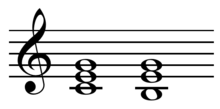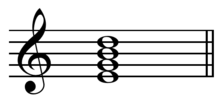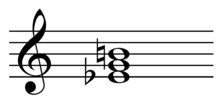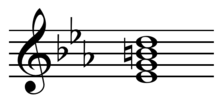- Mediant
-
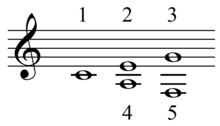 "1. Tonic, 2. Mediant, i.e., half-way to dominant, 3. Dominant, 4.Sub-Mediant, i.e., half-way to sub-dominant, 5. Sub-Dominant."[2]
"1. Tonic, 2. Mediant, i.e., half-way to dominant, 3. Dominant, 4.Sub-Mediant, i.e., half-way to sub-dominant, 5. Sub-Dominant."[2]
In music, the mediant (Latin: to be in the middle[3]) is the third scale degree of the diatonic scale, being the note halfway between the tonic and the dominant.[4] Similarly, the submediant is halfway between the tonic and subdominant.[5] The fifth note is almost always a perfect fifth, while the third note can equally be a minor or major third.
In Roman numeral analysis, the mediant chord can take several forms. In major scales, the mediant chord is minor and is noted with the Roman numeral iii. In a natural minor scale, the mediant occurs as a major chord, noted with the Roman numeral III. In harmonic minor scales and ascending melodic minor scales, the seventh scale degree is raised by a half-step from a subtonic to a leading tone, creating an augmented mediant chord, noted with the Roman numeral (♭)III+.
For example, in the C major scale (white keys on a piano, starting on C), the mediant is the note E; and the mediant chord is E-minor consisting of the notes E, G, and B. Therefore, Em is the iii chord in the C major scale. Also, in the A natural minor scale (same white keys, but now starting on A), the mediant is the note C; and the mediant chord is C (or C-major) consisting of the notes C, E, and G. Therefore, C is the III chord in the A (natural) minor scale. However, if the harmonic minor scale is used, G would be raised to G♯, changing the C chord to Caug, consisting of the notes C, E, and G♯. Therefore, Caug is the III+ chord in the A harmonic minor scale.
"Mediant" also refers to a relationship of musical keys. For example, relative to the key of A (natural) minor, the key of C major is the mediant, and often serves as a mid-way point between I and V (hence the name). Tonicization or modulation to the mediant is quite common in pieces written in the minor mode, and usually serves as the second theme group in sonata forms, since it is very easy to tonicize III in minor (no need to alternate notes). Tonicization of III in major is quite rare in classical harmony, compared with, say, modulation to the V in major, but mediant tonicization in major is an important feature of late romantic music.
In German theory derived from Hugo Riemann the mediant in major is considered the dominant parallel, Dp, and in minor the tonic parallel, tP.
See also
Sources
- ^ Benward & Saker (2003). Music: In Theory and Practice, Vol. I, p.230. Seventh Edition. ISBN 978-0-07-294262-0.
- ^ MacDowell, Edward A. (2008 edition). The Music-Lover's Handbook, p.167. ISBN 1-4437-8087-1.
- ^ "Mediant", Merriam-Webster.com.
- ^ Benward & Saker (2003), p.32.
- ^ Benward & Saker (2003), p.33.
Degrees and functions of the diatonic scale 





(♭) 

C D E F G A B♭ B niger
Categories:- Diatonic functions
- Scale degrees
Wikimedia Foundation. 2010.

